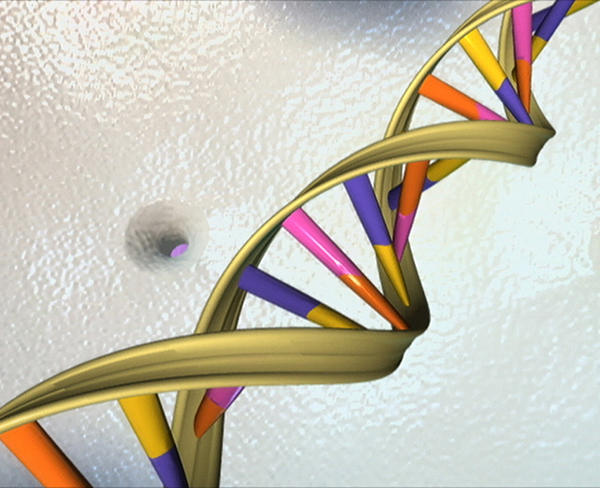Scientists Identify Potential Marker of Resistance to PARP Inhibitors
, by NCI Staff
A team led by NCI researchers has identified a potential biomarker that could help predict whether a tumor will respond to a relatively new class of targeted cancer drugs known as PARP inhibitors.
The team’s findings, published September 27 in Oncotarget, showed that cancer cell lines with high expression levels of the gene SLFN11 were more sensitive than cells with low SLFN11 expression to the PARP inhibitors olaparib (Lynparza™) and talazoparib. Cancer cell lines in which the SLFN11 gene was inactivated were resistant to both drugs.
Olaparib is approved by the Food and Drug Administration for the treatment of certain patients with advanced ovarian cancer whose tumors have mutations in the BRCA1 or BRCA2 genes. Olaparib and other PARP inhibitors are also in advanced clinical testing for other cancers, including prostate, breast, and colon cancer.
The new study also provided evidence that another class of drugs called ATR inhibitors, which are being studied for the treatment of various cancers, may be able to overcome resistance to PARP inhibitors caused by inactivation of SLFN11.
Links Between SLFN11 and Response to DNA-Damaging Drugs
Previous work by the NCI team, led by Yves Pommier, M.D., Ph.D., of NCI’s Center for Cancer Research, and by others, has shown that SLFN11 is inactivated in nearly half of all human cancer cell lines tested. SLFN11 expression also varies widely in tumor samples from patients with ovarian, breast, lung, prostate, and colon cancer, as measured in samples from The Cancer Genome Atlas, Dr. Pommier said.
PARP inhibitors block the actions of the PARP family of proteins, which play an important role in repairing DNA damage in cells. Cancer cells that cannot repair their damaged genetic material die.
Previous studies by Dr. Pommier’s lab, using data from the NCI-60 human tumor cell lines screen, revealed a previously unsuspected association between SLFN11 expression and responsiveness to a broad range of DNA-damaging cancer therapies, including topoisomerase inhibitors and cisplatin. Specifically, they observed that cells with high expression of SLFN11 are more sensitive to these drugs than cells with low expression.
To examine whether SLFN11 expression is also associated with the response to PARP inhibitors, Dr. Pommier’s team studied several human tumor cell lines with varying levels of SLFN11 expression. They found a correlation between higher SLFN11 expression and higher sensitivity to olaparib and talazoparib, two of the most potent PARP inhibitors. In addition, tumor cells in which the SLFN11 gene was experimentally inactivated were also resistant to both drugs.
The team also showed that, in mouse models of small cell lung cancer, inactivation of SLFN11 was associated with resistance to combination therapy consisting of a PARP inhibitor and the chemotherapy drug temozolomide. A recent study by researchers at Memorial Sloan Kettering Cancer Center reported similar findings.
Tumors with mutations in the BRCA1 or BRCA2 genes—which are involved in repairing DNA damage in cells—are known to be particularly sensitive to PARP inhibitors, Dr. Pommier said. But in their study, he continued, “we found that regardless of whether the BRCA gene is switched off or on, if SLFN11 is off, the cancer is resistant to PARP inhibitors; if SLFN11 is on, the cancer will tend to be sensitive to PARP inhibitors.”
These findings, he said, suggest that, in addition to BRCA mutations, expression levels of SLFN11 can be considered as criteria for the use of PARP inhibitors.
Overcoming Resistance
Finally, Dr. Pommier’s team investigated whether a drug that blocks the actions of a protein known as ATR could make tumors with inactivated SLFN11 sensitive to PARP inhibitors. ATR plays a key role in coordinating DNA repair and the progression of cells through the cell cycle—the series of steps a cell goes through each time it divides. When a cell’s DNA is damaged, ATR puts the cell cycle on hold, essentially giving the cell time to repair the damage before it continues to divide.
For these experiments, the team used four human cancer cell lines in which they had experimentally deleted the SLFN11 gene. These experiments showed that treating cells lacking SLFN11 with ATR inhibitors could restore their sensitivity to olaparib and talazoparib.
“Clinicians who are designing clinical trials need to have preclinical data to justify whether they should combine two drugs,” Dr. Pommier said. “We provide evidence that even if SLFN11 is off and a tumor is intrinsically resistant to a PARP inhibitor, you may be able to convert it to a sensitive tumor by adding an ATR inhibitor.”
Potential Clinical Applications for Precision Medicine
The study’s lead author, Junko Murai, M.D., Ph.D., said she hopes to develop SLFN11 expression as a biomarker to predict which patients are most likely to respond to PARP inhibitors.
That will require additional studies to measure SLFN11 expression in patient tumor samples, rather than in cell lines or mouse models. So far, Dr. Pommier’s team has done retrospective studies looking at SLFN11 expression in tumor samples from patients treated with DNA-damaging drugs. In one study, for example, patients with ovarian cancer who had been treated with cisplatin tended to have better outcomes if their tumors had high SLFN11 expression levels than if they had low levels. Another study showed a similar pattern in patients with Ewing sarcoma treated with a topoisomerase inhibitor or with olaparib and temozolomide.
But more rigorous evidence from clinical trials is needed before SLFN11 expression can be used as a biomarker of responsiveness to PARP inhibitors and other DNA-damaging agents, Dr. Pommier said. In a clinical trial, researchers could test the levels of SLFN11 expression from tumor samples obtained immediately before patients begin drug treatment and assess whether its expression is correlated with the response to treatment.
Another important next step, the study authors said, will be to better understand the mechanism of action of SLFN11 in the response to PARP inhibitors.
